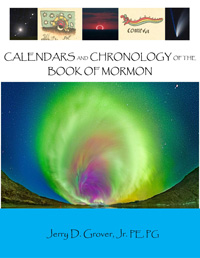Introduction
Anyone that has read the entire Book of Mormon, whether believer or not, will note that the book is heavy in chronological structure, from the various prophecies fulfilled after a specific number of years, to the continuous mention of nearly every year in certain periods such as the Reign of the Judges.
Those that maintain that the Book of Mormon is an actual historical text recognize that it must have taken place in a particular place and at a particular time. While there are a few different geographic models for the location of the Book of Mormon, this book is based on the premise that it took place in Mesoamerica, which also is consistent with the Mesoamerican practice of the integration of calendars directly into religious practice and ritual.
Back in the 1980's I took an anthropology class at BYU where some elements of the Book of Mormon were discussed. On the final exam, there was a true and false question as to whether the "400 year" prophecy of the Nephite destruction is equivalent to the Maya Baktun. There was also an essay question asking how you can detect the Maya "tun" calendar system in the Book of Mormon. Of course, in order to get a good grade, I had to put "true" and then proceed to include in the essay question the predetermined justification of the "tun" calendar that the professor was looking for. However, I had run the calculations myself with the Book of Mormon calendar, and it was very clear that the "tun" calendar simply did not work with the Book of Mormon calendar. I thought that one day when I was older, I might look at this issue closer and see what I could come up with.
There have actually been very few scholars who have written specifically addressing the Book of Mormon calendars, most with the primary purpose of attempting to tie the Lehite departure to the Old World calendar and also tangentially to attempt to give further clarity to the birth and death dates of Christ. While the issue of the connection of Old World to Book of Mormon calendars will be discussed, a primary purpose of this work is to apply and flesh out the new calendrical information obtained from the "Caractors" Document to solve some calendrical problems that have perplexed Book of Mormon scholars in the past and show new textual correlations to some of the dates and calendars.
The Caractors Document is a previously under-utilized, or simply unused, key source for Book of Mormon chronology. The Caractors Document (sometimes conflated with the Anthon transcript) consists of some 222 reformed Egyptian characters copied from the Book of Mormon plates. This document, recorded in the handwriting of Joseph Smith's early scribe John Whitmer, and laid out in seven rows on a torn sheet, has been an enigma since the early days of the Restoration. While it may initially seem daunting, or even impossible, that one might translate those characters, several fortuitous factors make its translation possible and plausible. First, Egyptian, Hebrew, Sumerian, Mayan, and other languages that contributed to the language, number system, and calendars of the Nephites are known, providing scripts, vocabularies, numbers, and language structures that are found in reformed Egyptian. Second, we possess the contents of the Book of Mormon, which can be compared against identifiable elements on the Caractors document to discern which portion of the Book of Mormon the Caractors document corresponds to. Third, research by previous scholars identified many Egyptian numbers on the Caractors document, which assists in identifying what type of text the Caractors document represents, and where in the structure of the Book of Mormon it would be found. Fourth, leveraging the xviii initially identifiable words and numbers on the Caractors document it is possible to identify the document as Mormon's chronological summary of the period from the 19th regnal year of Mosiah1 to the coming of the Limhites (likely the preface to the Book of Mosiah), and also Mormon's synopsis of the Book of Mormon Prophetic Calendar (Grover 2019). Since much of the meaning of a text is contextual, establishing this context enables the further translation of characters in the document, each of which, in turn, provides still further context interpreting and refining the meaning behind other characters in the text. In this fashion, the author was able to systematically work out the content and meaning of the Caractors document in a previous volume. Because this content, thus discerned, is greatly focused on ma ers of chronology and calendar it is uniquely suited to assist in establishing the Nephite calendars and chronology of Book of Mormon events in the present work. Specifically, the Caractors Document provides the following new calendrical information:
1. The existence of a Jubilee year count
2. A new date for Christ's death provided in a Reign of the Judges date
3. A new count from Christ's death to his appearance and ascension to the Nephites
4. A new sub-calendrical period called the Period of the Seven Tribes
5. A new count from the appearance of Samuel the Lamanite to the birth of Christ
6. Glyphic evidence in the reformed Egyptian that a solar calendar was used after Christ's birth
In addition, new information regarding Christ's birth will be integrated into the analysis. The approach taken will be first to further establish an internally consistent Book of Mormon chronology including the relationship of multiple calendars and correlations with the text. New textual evidence of these calendars will be discussed. Although part of an earlier publication, the Nephite number system and its use of sacred numbers, specifically as it applies to patterns of year counts, will be extensively discussed.

